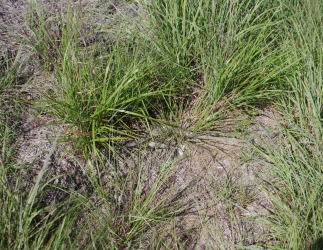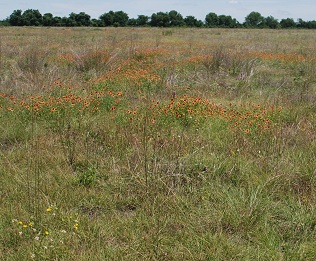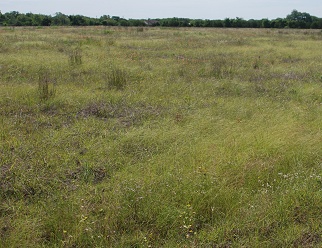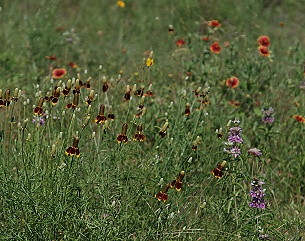If land managers had ten thousand years to play with the land, prairie restoration would be a lot easier, even if they had to start with an overgrazed, eroded, compacted, heavily-invaded, polluted mess. But we don’t. So some basic principles have been laid down–initially during research on northern prairies–that now govern most prairie restoration projects: physical removal of invasive woody plants by fire (cheap) or various mechanical clearing methods (more expensive) , grazing management to interrupt succession, physical disturbance of the soil (discing, for instance) to induce germination of dormant seeds.
The problem for managers today–especially small-acreage managers–is that some of these methods are no longer permissable or even wise. For us, for instance, with our land partly surrounded by homes and a construction firm that stores fuel and other flammables onsite, fire is not a good option even if we could get a permit to burn. Our land is too narrow; fire could easily get off the place and threaten homes or (at the construction yard) go on to threaten a nearby store. Moreover, fire produces air pollution that is unhealthy for people and livestock. Our land is too small to support a cow herd. Left to its own devices, it was already (before we bought it) becoming covered with Ashe juniper, a tree that readily invades overgrazed pastures around here. So–if we can’t have cattle and can’t use fire–what *can* we do? And does it work?
So far, we’ve continued to see increasing diversity of native plants, a healthier structure, less erosion (no erosion for most of it) with other methods. This discussion will center on the succession from bare to King Ranch Bluestem as the dominant grass to replacement of KRB by native grasses and forbs.
At stage one, the land had been eaten nearly bare over much of it during the tenancy of the previous renter. The renter before that had sown “improved” pasture grass (King Ranch Bluestem, Bothriochloa ischaemum, and possibly also Silky Bluestem, Dichanthium sericeum) but these grasses, like all the natives that had survived at all, were eaten down to the crown.
That first spring, we had abundant wildflowers, especially bluebonnets and gaillardia, forbs that do very well on poor soil. By the next year, the grasses were recovering, so we had more grass and fewer wildflowers, a trend that continued for several years, as we wanted grass roots to hold the soil. Meanwhile, we were clearing off the invasive juniper, prickly pear, and mesquite, by hand. We harvested seed from native grasses on the place and spread it on the bare patches (especially little bluestem, Indiangrass, and sideoats grama.) We did root transplants of “heritage” grasses from the grass garden near the house (eastern gama, switchgrass, big bluestem, a few others) into the habitats we thought they’d like best.
By year three, although we had found areas of native grasses here and there, the area most disturbed by former renters (including used for winter wheat and oats by one) was heavily dominated by King Ranch Bluestem–a grass that–for a time–outcompetes desirable forbs by choking them out. Only Maximilian sunflower seemed able to make headway against it. Where we mowed it (for maintenance paths) it formed mats; where we didn’t, it grew tall and then lay over in a heavy thatch. A few of the tough natives (including Silver Bluestem, Bothriochloa saccharoides, Little Bluestem, Schizachyrium scoparium, and Indiangrass, Sorghastrum nutans) moved into the bare areas, but KRB seemed to have a lock on the west end grass. We read (and were told by some) that we would have to burn or poison or otherwise get rid of the KRB to restore native plants.
But about year seven-eight, the KRB began killing itself–it’s apparently fairly short-lived–and for one year we had ugly gray mats of thatch lying in heaps, with only the stoutest of prairie forbs (cow parsley, for instance, and Baccharis) penetrating it. Then the meadow dropseed, Sporobolus compositus var. drummondii, a delicate-looking, fine-leaved grass, began coming up in the thinner-thatched areas, soon followed by other desirable plants, both grasses and forbs.

The thatch protected the soil from heavy downpours, preventing erosion, and also kept the soil itself cooler.
Where the regrowth was initally too coarse (sparse growth of mostly invasive forbs or woody plants and no grass), mowing in offset blocks for two years running produced a good effect:

This is a view across the west part of the west grass, looking north from near the south fenceline. This part of the west grass now supports a variety of forbs (gaillardia showing most, but note Texas Star in foreground), and five or six grass species so far; diversity is still increasing. Last year, for instance, a species new to the place showed up for the first time, Eupatorium serotinum. Our management plan here will be for alternate year mowing of the offset blocks as the KRB dies off (since mowing appears to regenerate KRB.)
In another part of the west grass, with different initial conditions, recovery of natives through KRB thatch was faster and looks different:

This view across the west grass looking SE to the south fenceline shows an area that had gaps in the KRB coverage, quickly invaded by dropseed and silky bluestem when freed of heavy grazing pressure. Small areas of other grasses had also persisted (protected by, for instance, broomweed which formed a scratchy and irritable barrier to grazers.) As the KRB died off, these patches persisted, and included shortgrasses like buffalograss, Texas grama, curly mesquite, and various 3-awns, and mid-grasses like the dropseed, silky bluestem, silver bluestem, little bluestem, and Indian grass (originally the only true tallgrass on the place, though its history included tallgrass prairie.) All these have increased. The pale yellow-green patches in this picture are mostly dropseed, with some silky bluestem. The upright “tufts” in the mid distance are little bluestem. As time has passed, this area (with thinner soil than the south half) has revealed multiple ‘discoveries’ of old prairie survivors that were not here for the first years we owned the place. Partridge pea, Illinois basketflower, Illinois bundleflower, Two-leaf senna, Devil’s claw, etc.
So…in nine years, the west grass has gone from mostly bare to a grass we didn’t want as the dominant to recovery with native grasses and forbs–a recovery still incomplete, but obviously continuing to make progress. Considering the whole place, the diversity has increased: from 26 species of grass to start with (including nonnatives like KRB, silky bluestem, and Johnson grass) to 50, and forbs from 65 to 150. Are we “there” yet? Certainly not. We still have invasive woody plants, forbs, and grasses to deal with every year (Johnson grass is apparently immortal…you think you’ve got it all and you haven’t.) We won’t be “there” by the time we did–but the land itself is telling us we’re on the right track. After last year’s severe drought, it responded to this spring’s still-meagre rains like this:

Some of the wildflower-specific posts show wildlife as well–the increasing diversity of plant-life and physical structure in the west grass has increased the number of butterflies and other insects (including honeybees and other bees) using this resource, and also the number of birds (both species and individuals) that are found here. Nor are they alone, as mammals, reptiles and even amphibians (in wet weather) are found here.
Comment by elizabeth — June 4, 2009 @ 12:27 pm
I had no idea Word would attach all that formatting to *one copied word* from a file. I knew it would add formatting to a whole file importanted here, but one little scientific name?
Yeesh.
Comment by green_knight — June 4, 2009 @ 4:18 pm
Fascinating stuff. I’m working on a *much* smaller scale – I’m managing my gardens which are probably around 1/10th of an acre, but I’m interested in the same principles – native species, curbing invasive weeds, attracting insects, and I am always inspired by your work.
The problem is, of course, that while I can afford to keep my land largely unproductive, farmers can not. Would it be possible to graze cattle on your land without tipping the ecosystem over the edge again?
Comment by elizabeth — June 4, 2009 @ 9:31 pm
Here, the minimum acreage per animal unit is 15 acres and in drought conditions, more is needed. (For those reading who aren’t aware, an “animal unit” or AU is a cow/calf pair. A horse is 1.5 AU. Cattle also need a reliable permanent water source–there’s no permanent water on the place, and we don’t have enough rainwater capture there to ensure adequate water for livestock.
Of our 80 acres, something over 20 should be protected from grazing because it’s streamside or desirable woods/brush that grazing degrades. Another 10-15 is across the creek and thus inaccessible without building a “drive” through the creek woods (which would wash out with every flash flood.) That leaves ~45-50 acres of open grassland this side of the creek. We could at most graze three cows on it, and it would require building interior fence to fence off the areas that should not be grazed at all. (The land came with highly permeable old fences on the outside perimeter only–Richard’s rebuilt a lot, but not all, of the perimeter fence. One-man fence-building is slow going–and he’s good at it. Also expensive.) Hence, it’s not really feasible in terms of the water supply, the time we have, the cost of fencing materials. Much more reasonable to keep our cows over on John’s ranch, where they have water wells, are in their “home herd,” and there are working pens for catching them when it’s needed.
Now if I could afford the additional acreage just south of ours, which has at least one well…then I’d definitely move my girls over here, and a young bull with them.
Comment by elizabeth — June 4, 2009 @ 10:51 pm
I should add that “afford the additional acreage” would have to include “afford the fence crew to build the fence necessary to manage appropriate grazing rotation and also build two more rain barns to capture and store water for the cattle, and also provide working pens for loading/unloading them as needed.”
And then I’d want a barn like John’s (only with water laid on as well as electricity) and a complete home-slaughter/meat-packing setup, and if I have the money for all that, why not also a small hog facility, a new chicken house…and pretty soon I need a foreman and crew on permanent salary…
Best stick to what I’ve got…
Comment by green_knight — June 5, 2009 @ 6:06 am
I’m surprised at the horse:cow conversion – I’m used to operating on a mental number of two cows per acre, one horse per 2.5 acres or thereabouts – then again, dairy grass around here is so rich it’s causing no end of problems in horses.
Comment by elizabeth — June 5, 2009 @ 8:04 am
Now *that’s* interesting…supposedly our AU ratios were worked out by research on actual pasture, but there’s always been understanding that the nature of the pasture (entirely grass, various ratios of grass and forbs and woody plants) affect the actual stocking rate for each species (goats, for instance, happily chomp down on things a cow won’t touch.) Maybe the figures I’ve seen are wrong–certainly I’ve observed that horses’ hooves do a different kind of damage to the ground than bovine hooves.
Rich grass is a problem with horses, yes, and so are some specific grasses that become very toxic in some conditions for some species. Klein grass, another “improved pasture grass,” is an excellent grass for cattle here, but a urinary toxin for horses (I can’t recall now if it’s worse for geldings or mares, but there’s a sex difference.) Johnson grass, imported as an “improved pasture grass,” turns out to contain cyanide when it regrows after stress (drought or hard frost) and then is lethal to any livestock. My horses are both browsers as well as grazers, especially Bananaface, and the 80 acres have plants toxic to horses that he has already demonstrated an appetite for: lantana, the various milkweeds. The native milkweeds are mildly toxic to cattle, but usually cattle don’t try them. (I want the milkweeds as support for the milkweed butterflies.)
Dairy cows here (as opposed to beef cows) are generally housed only on irrigated, special pastures or well east of here where the rainfall is much higher–you don’t want your dairy herd spread out across hundreds of acres, eating native plants that make the milk bitter. Cattle around here are all beef cattle. The drought of the past 20 months has forced everyone to cut their herds drastically.
Comment by Marjorie Procter-Smith — June 5, 2009 @ 10:30 am
I’m always fascinated to read about your progress with your land. I agree about the Johnson grass. We thought we had it pretty well under control on our 44 acres for the last couple of years, with native grasses, or at least forbs, crowding it out. But there is much more of it this year than last year, especially where the feral hogs rampaged (a word that was surely invented to describe what feral hogs to do a field or prairie) and disturbed the dormant seeds. I wish I were better at identifying grasses, though. I know we have several different types of bunchgrasses, but am not confident about my IDs. I looked at your booklist here; is there any book on grasses you would recommend for an amateur to start with?
Comment by elizabeth — June 5, 2009 @ 11:08 am
Grass ID is *hard*. I made a lot of mistakes early on. They’re hard to photograph (for amateurs like me, anyway), and I find them hard to learn from books of pen & ink illustration. I used multiple books with multiple illustrations…sometimes a grass that looked “sorta” like my specimen in one or two books suddenly popped out as “obvious” in another.
Of all the books, I found the Wasowski books on gardening & landscaping with native Texas plants very useful because of the superb quality of the photography. Also useful was Loflin & Loflin’s _Grasses of the Texas Hill Country_, published by Texas A&M. You should also be able to get your county agent or regional biologist to come out and ID some of your stuff, and if you’re fabulously wealthy (!) you can get Plateau Management to send out a field biologist to walk your place with you and ID everything in sight.
I am sure we’ll get the feral hogs on our place sometime. Do Not Want. (Thinking “smokehouse” thoughts at the feral hogs. I understand they’re delicious…)
Comment by Caryn — June 5, 2009 @ 1:03 pm
Fascinating. And good to know.
I’m in the Pacific NW and when we bought our place almost 20 years ago the grove of evergreen trees in the back of the 1/4 acre was there but the previous owners had used lime to de-acidify the soil so grass would grow. Very bad for the trees, however. We’ve let it return to duff mostly, and have to mow what grows there a couple of times a summer, but the trees seem much happier for it. (Cedars, hemlock, Douglas fir, all about 50 years old or older, and about 100′ tall.)
Comment by elizabeth — June 5, 2009 @ 2:12 pm
Ouch! Changing the basic soil characteristics of a region, except maybe to grow some vegetables (we do that for the vegetable garden,in raised beds) is a) very difficult and impermanent and b) not good for the native plants, you’re quite right. Our soil is neutral to alkaline–being over a limestone base–and people who try to grow acid-loving plants here have a terrible time. We can grow only trees that tolerate alkalinity at depth (and none of them grow 100 feet tall–not in out low rainfall/high heat conditions!)
The original vegetation right where we are was prairie, with riparian woods on the stream bottoms, and mixed brush on some of the rocky higher slopes.
Comment by Marjorie Procter-Smith — June 5, 2009 @ 6:10 pm
Nope, not wealthy (financially, anyway). Have even thought of inviting a local high school ag class or 4-H group to come do a grass ID project on our land (ah, free help, passing as education!). Our regional Parks and Wildlife guy has been out, and was very very helpful in identifying some of our plants, especially grasses. And I have the “Know Your Grasses” printout (the drawings are minimally helpful, in my opinion). But I’m heading my pointer for Amazon to look for the two books you recommend. Thanks!
Comment by elizabeth — June 5, 2009 @ 6:23 pm
Yeah, we can’t afford to have Plateau come out either. I have probably a half dozen to a dozen grass books…you’ll find, as you gradually nail down some of them, that the others will begin to fall into groups, and then it’s somewhat (!!) easier to figure them out from multiple sources. But they’re just not easy. (Or, the easy ones are, like brownseed paspalum or big bluestem, but there are all these mid-size bunchy things…)
You’ll get it, in time, though maybe not all of them. I still don’t have *all* of them.
Comment by Marjorie Procter-Smith — June 5, 2009 @ 8:10 pm
Regarding the question above from “Green Knight” about grazing on recovering prairie land reminds me of a local (Navarro County, Texas) family, the Prices, who have raised (beef) cattle for generations, who converted from conventional methods to native grass feeding, and who, a couple of years back, won the Aldo Leopold Award for their efforts. So combining land restoration with commercial beef cattle can be done.
And, coincidentally, a neighbor who is raising grass-fed organic beef just dropped by to deliver some ground beef we ordered, noticed our back prairie full of Johnson grass, and wondered whether we would consider renting it out for her (or others’) cattle to graze the grass down.
In light of your comments above regarding possible toxicity of Johnson grass to cattle, and the large number of milkweed we have (and which, like you, we encourage for the butterflies), what do you think of our neighbor’s question?
Comment by elizabeth — June 5, 2009 @ 10:01 pm
Well…Johnson grass is toxic only when it’s producing cyanide. Of course, you find out that it’s producing cyanide when the stock die, but you can sorta-kinda know when it’s likely to: a flush of growth after drought stress or right after a frost/freeze. Horses love Johnson grass (which does taste a little sweet–I’ve chewed Johnson grass stems back before I knew about the cyanide) and they, unlike cattle, will eat it down below the crown and nip it off the moment it sprouts back. I don’t know if there’s any kind of test you can do; one old boy told me that Johnson grass got a purplish cast to it when it was producing cyanide, but for all I know that’s an old boy’s tale. Then again, the old boys know a lot I still have to learn, sometimes. It’s figuring out what part of what they tell you is real that can be tricky.
OTOH, the milkweed…cows (unlike my idiot yellow horse) usually won’t touch it until the grass is really low, but even a little bit of it taints the milk with a nasty flavor.
We finally gave up and started using herbicide, spot treatments with a hand sprayer, on the Johnson grass and that’s made a big difference. It’s also the only thing that will take down Japanese honeysuckle and privet in the creek woods. Richard puts it on those in the winter, because their leaves stay green after others have dropped and gone dormant. That way it doesn’t harm them (I was skeptical, but we have more viburnum now…) It’s a foliar, and he puts it on the Johnson grass in summer. Usually takes 2-3 treatments per clump, and even then sometimes the rhizome isn’t quite dead. But at least it’s not taking over the place.
I guess it depends on whether you want to give the cattle two weeks to work on your Johnson grass (after warning your neighbor about the cyanide thing)…they probably can’t do any more damage than the hogs. But if you’ve got precious natives you don’t want them to eat–they will. For my horses, at least, the ice cream plants they’d go after first included the Johnson grass (yay!) but then Indiangrass (NOooooo!) and big and little bluestem–also silver bluestem which as you probably know is also sweet. Old boys around here call it sugar bluestem.